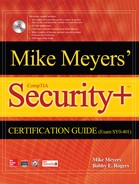CONTENTS
PART I The CompTIA Security+ Exam
Module 1 Meet the Security+ Exam
Why Do We Need Certification Exams?
Demonstrating and Validating Skills and Knowledge
The World of IT Security Certification
The CompTIA Security+ Examination
Module 1 Questions and Answers
PART II Stepping Up to IT Security
Module 3 The Basics of Security
Data Sensitivity and Classification
Module 3 Questions and Answers
Module 4 Understanding Security Governance
Module 4 Questions and Answers
Module 5 Questions and Answers
Putting It All Together: Determining Risk
Module 6 Questions and Answers
PART III Core Security Concepts
Module 7 Understanding Cryptography
Module 7 Questions and Answers
Module 8 Cryptographic Methods
Module 8 Questions and Answers
Module 9 Application of Cryptographic Methods
Application of Cryptographic Methods
Cryptographic Method Considerations
Module 9 Questions and Answers
Module 10 Public Key Infrastructure
Keys, Algorithms, and Standards
Digital Certificates and PKI Structure
Module 10 Questions and Answers
PART IV Authentication and Authorization
Module 11 Understanding Identification and Authentication
Module 11 Questions and Answers
Module 12 Understanding Authorization
Module 12 Questions and Answers
Module 13 Authentication Methods and Services
Authentication Protocols and Methods
Remote Access Connection and Authentication Services
Module 13 Questions and Answers
Module 14 User Account Management
Managing Privileges with User Accounts
Account Management Considerations
Module 14 Questions and Answers
Host-based Threats and Vulnerabilities
Module 15 Questions and Answers
Maintaining a Host Security Posture
Module 16 Questions and Answers
Module 17 Hardening Host Network Services
Network Protocols and the OSI Model
Module 17 Questions and Answers
Data Storage Controls and Methods
Module 18 Questions and Answers
Module 19 Questions and Answers
Secure Network Administration Principles
Module 20 Questions and Answers
Module 21 Questions and Answers
Securing and Defending Networks
Module 22 Questions and Answers
Module 23 Questions and Answers
Module 24 Host Application Threats
Module 24 Questions and Answers
Module 25 Web Application Threats
Module 25 Questions and Answers
Module 26 Application Hardening
Application Security Controls and Techniques
Application-Specific Attack Prevention
Module 26 Questions and Answers
Module 27 Internet Service Hardening
Internet and Application Service Protocols
Using Secure Protocols and Services
Module 27 Questions and Answers
Module 28 Virtualization Security
Using Virtualization for Security
Module 28 Questions and Answers
Module 29 Questions and Answers
Wireless Security Considerations
Troubleshooting Wireless Security Issues
Module 30 Questions and Answers
Module 31 Environmental Security and Controls
Temperature and Humidity Controls
Module 31 Questions and Answers
Module 32 Perimeter and Physical Controls
Module 32 Questions and Answers
Module 33 Third-Party Security
Third-Party Business Practices
Integrating Systems and Data with Third Parties
Third-Party Security Considerations
Module 33 Questions and Answers
Cloud Computing Risks and Virtualization
Appropriate Controls to Ensure Data Security
Module 34 Questions and Answers
Mobile Devices in the Business World
Mobile Security Concepts and Technologies
Application Control and Security
Module 35 Questions and Answers
Social Engineering Principles of Effectiveness
Module 36 Questions and Answers
Security Awareness and Training
New Threats and New Security Trends/Alerts
Module 37 Questions and Answers
Security Assessment Tools and Techniques
Interpreting Security Assessment Tool Results
Module 38 Questions and Answers
Executing an Incident Response
Module 39 Questions and Answers
Module 40 Forensics Procedures
Impartiality and the Collection of Evidence
Legal and Ethical Considerations
Chain-of-Custody and Securely Handling Evidence
Module 40 Questions and Answers
Risk Management Best Practices
Identification of Critical Systems and Components
Removing Single Points of Failure
Full Tests and Disaster Recovery Exercises
Module 41 Questions and Answers
Backup Execution and Frequency
Recovery Time and Recovery Point Objectives
Module 42 Questions and Answers
PART XIII Appendixes and Glossary
Appendix A Exam Objectives Map
Downloading Total Tester Premium Practice Exam Software
Total Tester Premium Practice Exam Software
Installing and Running Total Tester
Total Seminars Technical Support
